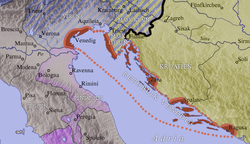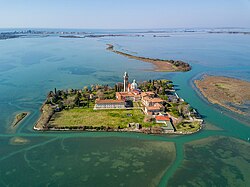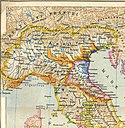The civil government at Grado Redenta (1917) (14596121917)
Identifier: 5926303upenn (find matches)
Title: The civil government at Grado Redenta
Year: 1917 (1910s)
Authors: Emilio Ferrando
Subjects: Grado (Italy) - History
Publisher:
View Book Page: Book Viewer
About This Book: Catalog Entry
View All Images: All Images From Book
Click here to view book online to see this illustration in context in a browseable online version of this book.
Text Appearing Before Image:
ck,with the women and children, and itwas a black night in every respect. Light shone upon the islandwhither they went, and they landedthere with nothing of their own, nei-ther dwellings, nor statues, nor trea-sures, only tears and confidence inthe future remained to them.n Thus rose the city, which theycalled Aquileia Nova, on a tongue ofland, possibly with more space thanthe old village, already inhabited bysome families of fishermen and ador-ned by some simple chapel. Thissite is at the end of the wide lagoonthat stretches from the Isonzo to PortoBuso and goes further on towardsMarano and Caorle, and finishesdown at the lagoons of Torcello,Murano, Venice, Chioggia. At that time there were onlymarshes with varying channels ac-cording to the depth of water, witha thick vegetation that hid the trea-cherous places, and imparted to theair a stagnant vapour, distressing forthose who contemplated living in thisdesolate region. Meanwhile Aquileia fell intothe hands of Attila, who sacked it
Text Appearing After Image:
Grado : A campiello. first, then gave it to the flames. No-thing but ruins remained where theold city had been. The fugitives made daring bytheir desperation, began the fightagainst new enemies, the waters, thesoil and the air, and they were con-querors after intense toil. They defined and set boundsto the banks of the channels by meansof wooden stakes, they raised thelevels and consolidated the surfaceswith mud dug from the channels,they utilised the water ways by wi-dening and straightening them, theyregulated the course of the risingwaters, in order to prevent destruc-tion of their improvement schemes,and employed these currents of waterfor transport. At last they workedin tree trunks, slabs, canes, and co-vered up with roots the first defencesagainst the storms. So grew up theearliest houses, more like sheds, butfar from any dangers of enemies. Thefugitives were prepared to encounter,after a primitive fashion, all the ter-rible perils of nature, so long as theywere finally freed f
Note About Images
Relevante Bilder
Relevante Artikel
Lagune von GradoDie Lagune von Grado, im örtlichen Dialekt Gravo, ist eine Lagune am äußersten Nordende der Adria. Ihren Namen trägt sie nach der Stadt Grado, einer italienischen Gemeinde mit wenig mehr als 8000 Einwohnern. Das Gewässer erstreckt sich über eine Küstenstrecke von 25 km von Fossalon di Grado bis zur Insel Anfora in Höhe der Flussmündungen von Ausa und Corno. Es umfasst eine Fläche von etwa 90 km²; zusammen mit der sich westwärts anschließenden Lagune von Marano umfasst die Lagune sogar 160 km². Die Tiefe des Gewässers schwankt zwischen 40 cm bei Ebbe und 80 cm bei Flut. Innerhalb der Lagune befinden sich etwa 30 Inseln. .. weiterlesen











